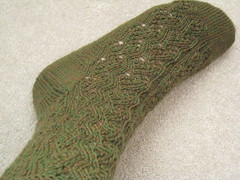 Here's an alternative way of picking up stitches from a cast-on edge. The main advantage to this technique is that it can be done in pattern -- in this case, a "k4, p3" pattern.
Here's an alternative way of picking up stitches from a cast-on edge. The main advantage to this technique is that it can be done in pattern -- in this case, a "k4, p3" pattern.The easiest cast-on edge to pick up from, using this technique, is a single (or backwards loop) cast on. The single cast on has less bulk as well. (The long-tail cast on would work as well since it looks exactly like a single cast on followed by a row of knitting.)
I'll be illustrating the technique for the bottom of an armhole for a raglan worked from the top down. The first picture shows the bottom of the armhole half done. The other half will be picked up after knitting around the rest of the armhole -- so that rounds will begin and end at the middle of the underarm.
 The first step is to identify the 2 loops of yarn over the first stitch to be picked up -- in this case, a knit stitch.
The first step is to identify the 2 loops of yarn over the first stitch to be picked up -- in this case, a knit stitch.One of these loops starts out as the right-hand-side of the stitch and then travels left over the stitch. The other starts out as the left-hand-side of the stitch and then travels to the right.
The second picture shows a crochet hook ready to pull yarn through the top of a knit stitch.
Once the loop is pulled through, place the yarn over the waiting needle so that the free end of the yarn (as opposed to the loose end) lies behind the needle. The part of the yarn nearest the loose end lies in front of the needle.
 The next stitch to be picked up is also a knit stitch. The 3rd picture shows the progress after 2 knit stitches have been picked up.
The next stitch to be picked up is also a knit stitch. The 3rd picture shows the progress after 2 knit stitches have been picked up.The next stitch to be picked up is a purl stitch.
 For purl stitches, the technique is a bit different.
For purl stitches, the technique is a bit different.Bring the yarn to the front of the work. Draw the yarn from front to back through the 2 loops at the top of the stitch. (The loops can be seen more easily from the back of the work.)
 The last picture shows the progress after 3 sts have been picked up. The next 2 sts to be picked up are also purl sts. So, the yarn should remain in front while picking up the stitches.
The last picture shows the progress after 3 sts have been picked up. The next 2 sts to be picked up are also purl sts. So, the yarn should remain in front while picking up the stitches.The last 2 sts to be picked up before working the sides and top of the armhole are knit stitches. The yarn should be moved to the back before picking up these stitches.
For the corner of the armhole, I haven't made up my mind whether or not to pick up one more stitch before knitting sts off the cable. Sometimes I pick up one more stitch from the same row; sometimes I don't.
Whichever, ..... I like to knit together the last picked up stitch with the nearest stitch on the cable (and also the first stitch to be picked up on the opposite side of the armhole with the nearest stitch on the cable).
To start working off the cable, of course, remove the cap on the cable and replace it with a needle (the same size or a smaller size than the one used to pick up sts). Slip the nearest stitch from the cable onto the needle used to pick up stitches. Then pass the second st on the needle (the last one picked up) over -- (or else, ssk). Work around, in pattern -- except, slip the last stitch on the cable onto the working needle. Pick up 1 st from the unworked side of the armhole. Place these 2 sts on a spare needle, pass stitch over, return the remaining st to the working needle (or else, k2tog)-- a mirror image of what was done on the opposite side of the armhole. Pick up the rest of the stitches at the bottom of the armhole, and begin working in the round.


